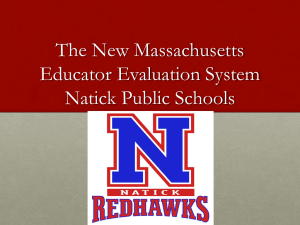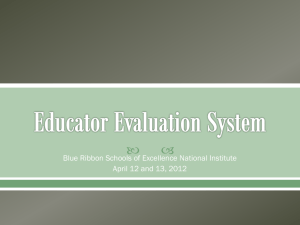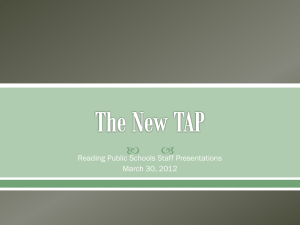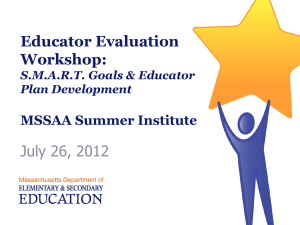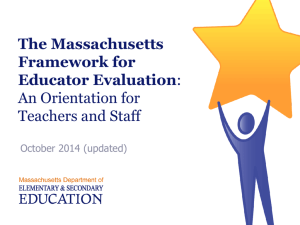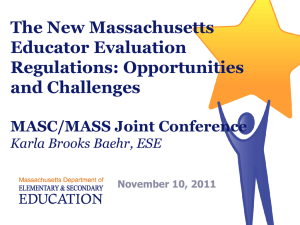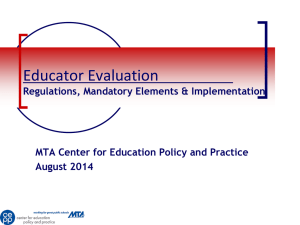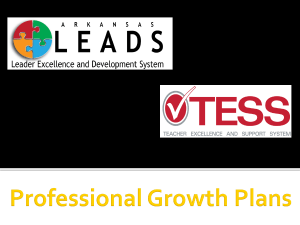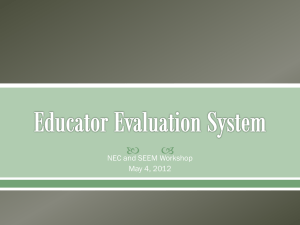Teachers 21 Presentation - RPSEducatorEvaluation
advertisement
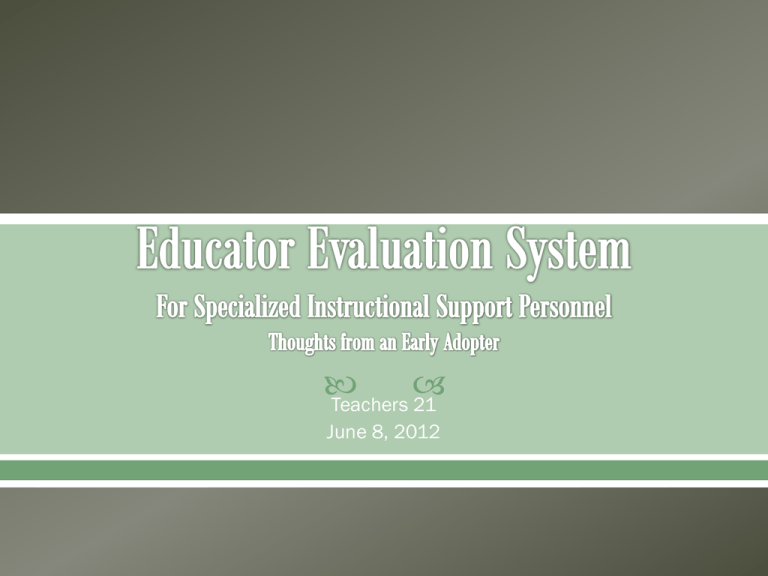
Teachers 21 June 8, 2012 Wiki with Resources o http://rpseducatorevaluation.wikispaces.com/ http://www.doe.mass.edu/edeval/model/ 3 New DESE Regulations approved on June 28, 2011 Collaboratively Designed by o Massachusetts Teachers Association o Massachusetts Association of Secondary School Principals o Massachusetts Elementary School Principals Association o Massachusetts Association of School Superintendents o Department of Elementary and Secondary Education Requires evaluation of all educators on a license Designed to promote leaders and teachers growth and development Our current system is comparable to new DESE model Allowed us to give significant input into the process Developed a network with other school districts Attended professional development opportunities Piloted o Educator Plan with SMART Goals o Superintendent’s Evaluation Process o Principal Evaluation Process Full Implementation of Educator Evaluation System in September, 2012 Focuses on Educator Growth and not “Gotcha” Five Step Evaluation Cycle o o o o o Rubric for Evaluation (Four Rubrics Developed) o o o o Self-Assessment Analysis, Goal Setting, Educator Plan Development Implementation of Plan Formative Assessment (Midyear or Mid-cycle) Summative Evaluation (End of Year/Cycle Evaluation) Superintendent Administrator Teacher Specialized Instructional Support Personnel Rubric Additional rubrics being developed for school nurses, school psychologists, school counselors, and business administrators Specificity of Rubric o Standards o Indicators o Elements Use of Artifacts for Evidence o Lesson Plans, Professional Development Activities, Fliers o Announced and Unannounced Observations Differentiated Approach o o o o Use of SMART Goals Levels of Performance on Rubric o o o o New Teachers Non-PTS Teachers PTS Teachers PTS Teachers who need additional support Exemplary Proficient Needs Improvement Unsatisfactory Multiple Measures of Student Performance (2013-14 School Year) Use of student surveys (2014-15 School Year) 5 Step Evaluation Cycle Continuous Learning Every educator is an active participant in an evaluation Process promotes collaboration and continuous learning Foundation for the Model Massachusetts Department of Elementary and Secondary Education 8 Every educator uses a rubric to self-assess against Performance Standards Rubric is used to analyze performance and determine ratings on each Standard and Overall Rubric is used to assess performance and/or progress toward goals Part III: Guide to Rubrics Pages 4-5 Professional Practice goals – team and/or individual must be tied to one or more Performance Standards Evidence is collected for Standards and Indicators; rubric 9 should be used to provide feedback Massachusetts Department of Elementary and Secondary Education 9 What does this look like? Counselor reviews data and identifies three areas for improvement, grade 8 transition issues for special education students, YRBS data for students feeling emotionally safe at school, and low participation levels for students in Teen Screen program Counselor receives a rating on each standard plus an overall rating based on performance against standards and progress on the three goals. Midway through the cycle, the Director of Guidance and counselor and department/teams to review evidence and assess progress on goals: makes adjustments to action plan or benchmarks, if needed. Continuous Learning Counselor works with Director of Guidance to develop a department professional practice goal on Grade 8 Transition. Works with health educators, social workers, and school psychologists on a team student learning goal to improve emotional safety of students, and works with Behavioral Health Coordinator on a team student learning goal increasing percentage of students who participate in Teen Screen program. Counselor gathers and synthesizes evidence on progress on goals in Educator Plan. Director of Guidance focuses data collection on goal areas. 10 The Developing Educator Plan (Non-PTS Teachers and teachers new to a position) is developed by the educator and the evaluator and is for one school year or less. The Self-Directed Growth Plan (PTS Teachers) applies to educators rated Proficient or Exemplary and is developed by the educator. When the Rating of Impact on Student Learning is implemented (beginning in 2013-14), educators with a Moderate or High Rating of Impact will be on a two-year plan; educators with a Low Rating will be on a one-year plan. The Directed Growth Plan (PTS Teachers) applies to educators rated Needs Improvement and is a plan of one school year or less developed by the educator and the evaluator. The Improvement Plan (PTS Teachers) applies to educators rated Unsatisfactory and is a plan of no less than 30 calendar days and no longer than one school year, developed by the evaluator. District Strategy Superintendent Goals School Improvement Plans Principal Goals Classroom Practice Teacher Goals Student Achievement School Committee Standards (4)-Required in Regulations o Curriculum, Planning, and Assessment (3 Indicators) o Teaching All Students (4 Indicators) o Family and Community Engagement (3 Indicators) o Professional Culture (6 Indicators) Indicators (16)-Required in Regulations Elements (34)-May be modified, but most keep rigor Rubrics o A tool for making explicit and specific the behaviors and actions present at each level of performance. Part III: Guide to Rubrics Page 6 Massachusetts Department of Elementary and Secondary Education14 Example: Specialized Instructional Support Personnel Rubric o Standard II • “Teaching All Students” o Indicator B • Learning Environment o Elements 1 & 2 • 2-B-1: Safe Learning Environment • 2-B-2: Collaborative Learning Environment • 2-B-3: Student Motivation 15 Part III: Guide to Rubrics Page 6 Massachusetts Department of Elementary and Secondary Education16 “The educator’s performance significantly exceeds Proficient and could serve as a model for leaders districtwide or even statewide. Few educators—principals and superintendents included—are expected to demonstrate Exemplary performance on more than a small number of Indicators or Standards.” Part III: Guide to Rubrics Page 14 Massachusetts Department of Elementary and Secondary Education 17 “Proficient is the expected, rigorous level of performance for educators. It is the demanding but attainable level of performance for most educators.” Part III: Guide to Rubrics Page 9 Massachusetts Department of Elementary and Secondary Education18 Educators whose performance on a Standard is rated as Needs Improvement may demonstrate inconsistencies in practice or weaknesses in a few key areas. They may not yet fully integrate and/or apply their knowledge and skills in an effective way. They may be new to the field or to this assignment and are developing their craft. Educators whose performance on a Standard is rated as Unsatisfactory are significantly underperforming as compared to the expectations. Unsatisfactory performance requires urgent attention. Standard II: Teaching All Students. Promotes the learning and growth of all students through instructional practices that establish high expectations, create a safe and effective classroom environment, and demonstrate cultural proficiency. Indicator II-A. Learning Environment: Creates and maintains a safe and collaborative learning environment that motivates students to take academic risks, challenge themselves, and claim ownership of their learning. Element IIB-1. Safe Learning Environment o Proficient-Uses rituals, routines, and appropriate responses that create and maintain a safe physical and intellectual environment where students take academic risks and most behaviors interfere with learning are prevented. Summative Rating Rating System Until Impact on Student Learning is Implemented in 2013-14/2014-15 Exemplary Proficient 1-YEAR SELF2-YEAR SELF-DIRECTED 2-YEAR SELF-DIRECTED DIRECTED PLAN GROWTHGROWTH PLAN GROWTH PLAN Needs Improvement DIRECTED GROWTH PLAN Unsatisfactory IMPROVEMENT PLAN IMPROVEMENT PLAN Low Moderate High Massachusetts Department of Elementary and Secondary Education24 Summative Rating Rating System for Educator Plan Once Multiple Measures are Implemented Exemplary Proficient 1-YEAR SELFDIRECTED GROWTH PLAN 2-YEAR SELF-DIRECTED GROWTH PLAN Needs Improvement DIRECTED GROWTH PLAN Unsatisfactory IMPROVEMENT PLAN Low Moderate High Rating of Impact on Student Learning (multiple measures of performance, including MCAS Student Growth Percentile and MEPA where available) Massachusetts Department of Elementary and Secondary Education25 Multiple sources of evidence inform the summative performance rating Massachusetts Department of Elementary and Secondary Education 27 Phase 1-Summative ratings based on attainment of goals and performance against the four Standards defined in the educator evaluation requirements (September, 2012) Phase 2-Rating of educator impact on student learning gains based on trends and patterns of multiple measures of student learning gains (September, 2013) Phase 3-Using feedback from students (for teachers) and teachers (for administrators)-(September, 2014) Opportunity to change teaching and learning o Focused Conversations o Creating Opportunity for Educator Growth o Leads to Student Growth o Tie in initiatives to educator evaluation Build trust with educators o Committee Work on Teacher Evaluation Process Educate the Community o School Committee Meetings o Community Forums Social Emotional Health Adopting the new MA Curriculum Frameworks 21st Century/Global Skills Anti-Bullying Professional learning communities Examining student work Data Teams Project Based Learning Common course/grade level assessments Elementary Report Cards BYOD Massachusetts Department of Elementary and Secondary Education30 This may be the most important initiative that you undertake in your district Look at this as an opportunity to improve teaching and learning and educator growth in your district Plan your strategy and process Train staff on how to write and implement SMART goals o Use the Train the Trainer Model o Use Special Education Teachers as Experts Collaboration is critical to the success of this implementation Link this system to the common core and assessment development Integrate the behavioral health framework into the system Transparent and ongoing open honest communication is critical Train all supervisors in the process to create inter-rater reliability Use the DESE materials Adopt the model rubrics Develop a logic model on how you will implement this process Involve your staff, school committee, and community early and often in the communication process John F. Doherty, Ed.D Superintendent of Schools, Reading Public Schools John.doherty@reading.k12.ma.us Reading Public School Educator Evaluation Wiki http://rpseducatorevaluation.wikispaces.com/
